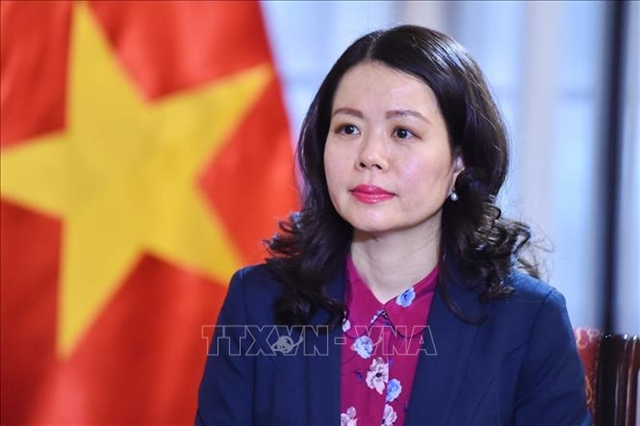 Society
Society


|
| The 2025 Job Fair at Hà Nội National University of Education receives a lot of attention from students.— VNA/VNS Illustrative Photo |
HÀ NỘI — Over the past decade, particularly during the past five years, more than 90 per cent of higher education institutions in Việt Nam have undergone quality accreditation, however, significant challenges remain in ensuring and maintaining quality across the country’s universities and colleges.
According to the Ministry of Education and Training, while the pool of domestic assessors has expanded and received training, it remains insufficient in both quantity and capability.
Many assessors still lack the expertise required for improvement consultancy, data analysis and assessing learning outcomes.
The limitation hinders universities from achieving the continuous improvement expected following accreditation, a core principle of any effective quality assurance system.
Another major challenge is the absence of mutual recognition mechanisms between Việt Nam and international accrediting bodies.
As a result, accreditation results obtained domestically are not widely recognised in joint training programmes, credit transfers or international ranking systems.
Moreover, Vietnamese accrediting organisations have had only limited participation in regional and global quality assurance networks.
Most have engaged merely as members or observers rather than contributing to standard-setting, expert exchange or training, largely due to the lack of long-term policy support and investment.
Associate Professor Nghiêm Xuân Huy, director of the Institute for Digital Training and Assessment at the Việt Nam National University-Hà Nội, said universities have yet to make effective use of stakeholder feedback in improving education quality, which directly affects both academic reputation and graduate employability.
He added that insufficient integration between training and scientific research has weakened research productivity and associated revenue streams.
Meanwhile, investment and strategic development for teaching staff have not delivered the desired results, affecting the lecturers’ quality and quantity.
Existing policies have failed to create strong incentives for academic staff to engage in research and publish internationally.
International collaboration in research remains mostly formalistic, lacking genuine networking or impact, and the proportion of foreign scholars remains low.
Huy stressed the need to build a robust quality assurance system characterised by transparency and active stakeholder engagement.
At the national level, he proposed improving regulatory frameworks, integrating ranking indicators into accreditation standards and fostering greater university autonomy.
He said: “Ranking should not be the ultimate goal, but rather the natural outcome of an effective quality assurance system.”
Professor Bành Tiến Long, former deputy minister of Education and Training, called for a shift from a static to a dynamic quality assurance model, from one based on fixed cycles and rigid rules to a more principle-based, continuously monitored and developmental approach.
He described this as a “constructive and quality-led model”, noting that recent changes in the draft amended Law on Higher Education and resolutions No. 57-NQ/TW and No. 71-NQ/TW all reflect the shift.
The accreditation system must move towards transparency, cooperation and effectiveness, with continuous quality enhancement at its core, thereby building a 'smart and humane' education system, he added.
Reforming evaluation
In the coming period, the ministry will continue reforming how it evaluates training programmes and higher education institutions.
Huỳnh Văn Chương, director general of the ministry’s Việt Nam Education Quality Management Agency, said the new evaluation framework will simplify the grading system from seven levels to two levels of 'Pass' and 'Fail'.
The change is designed to standardise and clarify outcomes while aligning with common practices in the US and Europe.
The new regulations will also clearly define 'conditional criteria', focusing on key aspects such as learning outcomes, faculty qualifications and internal quality assurance systems.
Institutions that fail to meet the conditions will not be recognised as meeting accreditation standards.
Crucially, universities will now be required to develop regular quality improvement plans, rather than conducting reviews only on a five-year cycle.
“The new rules aim for substantive accreditation and international integration, eliminating unnecessary requirements,” Chương added.
The ministry also encourages greater institutional autonomy in quality assurance and accreditation, linking it directly to rankings, degree recognition, credit transfers and international partnerships.
The overall direction for Việt Nam’s higher education quality assurance and accreditation system is to develop in line with the strategy of 'learning – practice – experimentation – employability', thereby strengthening the competitiveness and global standing of Vietnamese higher education.
Targets under Resolution 71
Chương added that the development orientation for higher education in the coming period is guided by resolutions No. 71-NQ/TW and No. 57-NQ/TW.
The documents set out a consistent vision anchored in key principles such as breakthrough innovation, modernisation, international standards, scholarship development and the enhancement of university autonomy regardless of the level of financial autonomy.
They also call for the continued restructuring of the higher education system at both central and local levels towards greater efficiency, streamlined organisation and clearly defined tiers and orientations.
Under Resolution No. 71-NQ/TW on breakthroughs in education and training, Việt Nam has set specific targets for higher education development.
By 2030, the country aims to have eight universities ranked among the top 200 in Asia and at least one ranked in the world’s top 100 in specific aspects.
All higher education institutions are expected to meet national standards, with 20 per cent reaching levels comparable to modern Asian universities.
At least 35 per cent of students will be enrolled in STEM fields and international scientific publications are to grow by 12 per cent annually.
By 2035, at least two universities are expected to reach the world’s top 100 in certain fields.
By 2045, Việt Nam aspires to have at least five universities in the world’s top 100, with its national education system ranking among the world’s top 20 in terms of quality, equity and modernity. — VNS




